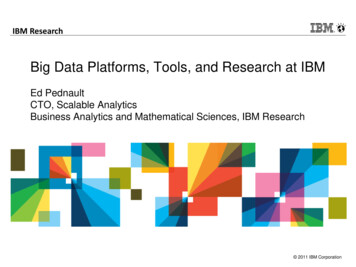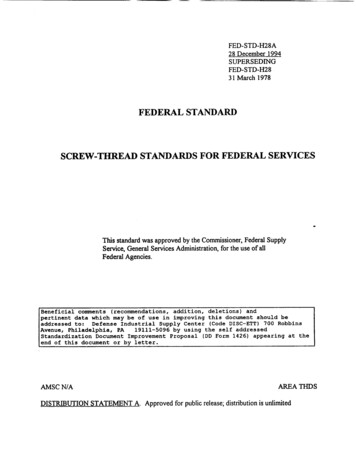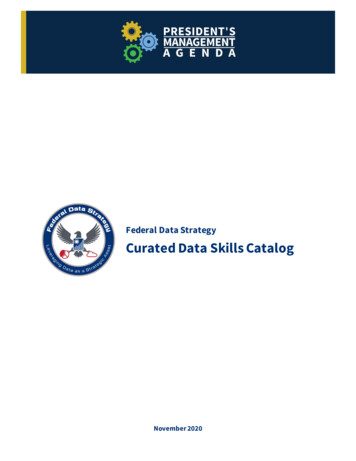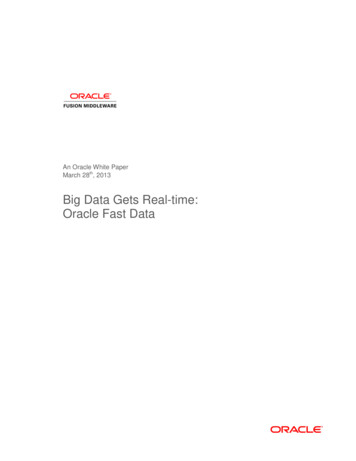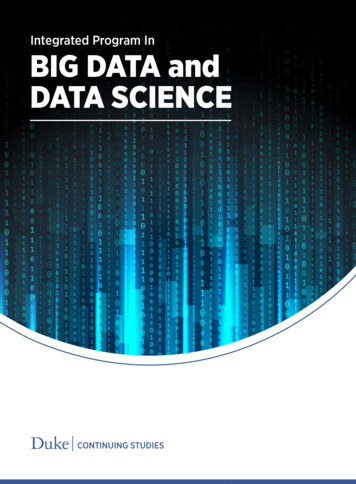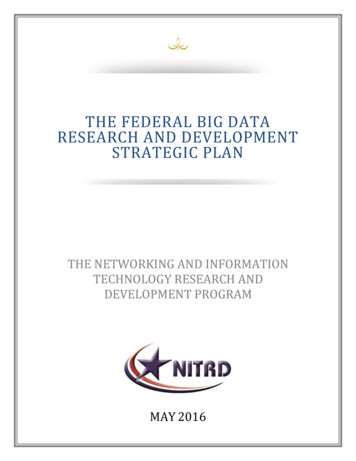
Transcription
THE FEDERAL BIG DATARESEARCH AND DEVELOPMENTSTRATEGIC PLANTHE NETWORKING AND INFORMATIONTECHNOLOGY RESEARCH ANDDEVELOPMENT PROGRAMApril 2016MAY 2016
About this DocumentThis report was developed by the Big Data Senior Steering Group (SSG). The Big Data SSG reports to theSubcommittee on Networking and Information Technology Research and Development (NITRD). Thereport is published by the Executive Office of the President, National Science and Technology Council.About the Subcommittee on Networking and Information Technology Research andDevelopmentThe Subcommittee on Networking and Information Technology Research and Development is a bodyunder the Committee on Technology (CoT) of the National Science and Technology Council (NSTC). TheNITRD Subcommittee coordinates multiagency research and development programs to help assurecontinued U.S. leadership in networking and information technology, satisfy the needs of the FederalGovernment for advanced networking and information technology, and accelerate development anddeployment of advanced networking and information technology. It also implements relevant provisionsof the High-Performance Computing Act of 1991 (P.L. 102-194), as amended by the Next GenerationInternet Research Act of 1998 (P. L. 105-305), and the America Creating Opportunities to MeaningfullyPromote Excellence in Technology, Education and Science (COMPETES) Act of 2007 (P.L. 110-69). Formore information, see www.nitrd.gov.About the NITRD Big Data Senior Steering GroupThe Big Data SSG was formed in 2011 to identify current Big Data research and development activitiesacross the Federal Government, offer opportunities for coordination, and identify what the goal of anational initiative in this area would look like. Subsequently, in March 2012, The White House Big DataR&D Initiative was launched and the Big Data SSG continues to facilitate and further the goals of theInitiative.AcknowledgmentsThis document was developed through the contributions of the NITRD Big Data SSG members and staff.A special thanks and appreciation to the core team of editors, writers, and reviewers: Lida Beninson(NSF), Quincy Brown (NSF), Elizabeth Burrows (NSF), Dana Hunter (NSF), Craig Jolley (USAID), MeredithLee (DHS), Nishal Mohan (NSF), Chloe Poston (NSF), Renata Rawlings-Goss (NSF), Carly Robinson (DOEScience), Alejandro Suarez (NSF), Martin Wiener (NSF), and Fen Zhao (NSF).Copyright InformationThis is a work of the U.S. Government and is in the public domain. It may be freely distributed, copied,and translated; acknowledgment of publication by the National Coordination Office for Networking andInformation Technology Research and Development (NITRD/NCO) is appreciated. Any translation shouldinclude a disclaimer that the accuracy of the translation is the responsibility of the translator and not theNITRD/NCO. It is requested that a copy of any translation be sent to the NITRD/NCO.
FEDERAL BIG DATA RESEARCH AND DEVELOPMENT STRATEGIC PLANSubcommitteeonNetworking and Information Technology Research and DevelopmentJames Kurose, Co-Chair, NSFKeith Marzullo, Co-Chair, NCONITRD Member AgenciesDepartment of CommerceNational Institute of Standards and Technology (NIST)National Oceanic and Atmospheric Administration (NOAA)Department of DefenseDefense Advanced Research Projects Agency (DARPA)National Security Agency (NSA)Office of the Secretary of Defense (OSD)Service Research Organizations (Air Force, Army, Navy)Department of EnergyNational Nuclear Security Administration (NNSA)Office of Electricity Delivery and Energy Reliability (OE)Office of Science (SC)Department of Health and Human ServicesAgency for Healthcare Research and Quality (AHRQ)National Institutes of Health (NIH)Office of the National Coordinator for Health Information Technology (ONC)Independent AgenciesDepartment of Homeland Security (DHS)Environmental Protection Agency (EPA)National Aeronautics and Space Administration (NASA)National Archives and Records Administration (NARA)National Reconnaissance Office (NRO)National Science Foundation (NSF)Office of Management and Budget (OMB)Office of Science and Technology Policy (OSTP)National Coordination Office forNetworking and Information Technology Research and Development (NITRD/NCO)
FEDERAL BIG DATA RESEARCH AND DEVELOPMENT STRATEGIC PLANBig Data Senior Steering GroupCo-ChairsStaffChaitanya BaruSenior Advisor for Data ScienceNational Science FoundationWendy WigenTechnical Coordinator, Big Data Senior SteeringGroupNational Coordination Office for Networking andInformation Technology Research and DevelopmentAllen DearryAssociate Director for Research Coordination,Planning, and TranslationNational Institute of Environmental Health Sciences(NIEHS)National Institutes of Health (NIH)MembersMarc AllenDeputy Associate Administrator for ResearchScience Mission DirectorateNational Aeronautical and Space Administration(NASA)Laura BivenSenior Science and Technology AdvisorOffice of the Deputy Director for Science ProgramsDepartment of Energy (DOE)Robert J. BonneauOffice of the Assistant Secretary of Defense forResearch and EngineeringOffice of the Secretary of DefenseStephen DennisProgram ManagerScience and Technology DirectorateDepartment of Homeland Security (DHS)Alan HallCLASS Operations Manager/ Enterprise ArchitectNational Oceanic and Atmospheric Administration(NOAA)Thuc HoangProgram ManagerOffice of Advanced Simulation and ComputingNational Nuclear Security Administration (NNSA)Department of Energy (DOE)Suzanne IaconoActing Office HeadOffice of Integrative Activities (OIA)National Science Foundation (NSF)James KeiserTechnical Director, Laboratory for Analytic SciencesNational Security Agency (NSA)John LaunchburyOffice DirectorInformation Innovation OfficeDefense Advanced Research Projects Agency(DARPA)James St. PierreDeputy DirectorInformation Technology LaboratoryNational Institute of Standards and Technology(NIST)James SzykmanEnvironmental EngineerEnvironmental Sciences DivisionEnvironmental Protection Agency (EPA)ParticipantsSky BristolApplied Earth Systems Informatics ResearchManagerUnited States Geological Survey (USGS)Department of the Interior (DOI)Mark PetersonDivision Chief for Data and AnalyticsUnited States Agency for International Development(USAID)
FEDERAL BIG DATA RESEARCH AND DEVELOPMENT STRATEGIC PLAN
FEDERAL BIG DATA RESEARCH AND DEVELOPMENT STRATEGIC PLAN
FEDERAL BIG DATA RESEARCH AND DEVELOPMENT STRATEGIC PLANContentsExecutive Summary . 1Introduction. 4Strategies. 6Strategy 1: Create next-generation capabilities by leveraging emerging Big Data foundations, techniques,and technologies . 6Scale Up to Keep Pace with the Size, Speed, and Complexity of Data .6Develop New Methods to Enable Future Big Data Capabilities .8Strategy 2: Support R&D to explore and understand trustworthiness of data and resulting knowledge, tomake better decisions, enable breakthrough discoveries, and take confident action . 11Understand the Trustworthiness of Data and Validity of Knowledge .11Design Tools to Support Data-Driven Decision-Making .14Strategy 3: Build and enhance research cyberinfrastructure that enables Big Data innovation in support ofagency missions . 16Strengthen the National Data Infrastructure .16Empower Advanced Scientific Cyberinfrastructure for Big Data .17Address Community Needs with Flexible and Diverse Infrastructure Resources .19Strategy 4: Increase the value of data through policies that promote sharing and management of data . 20Develop Best Practices for Metadata to Increase Data Transparency and Utility .20Provide Efficient, Sustainable, and Secure Access to Data Assets .22Strategy 5: Understand Big Data collection, sharing, and use with regard to privacy, security, and ethics . 24Provide Equitable Privacy Protections .24Enable a Secure Big Data Cyberspace .26Understand Ethics for Sound Data Governance .27Strategy 6: Improve the national landscape for Big Data education and training to fulfill increasing demandfor both deep analytical talent and analytical capacity for the broader workforce. 29Continue Growing the Cadre of Data Scientists .29Expand the Community of Data-Empowered Domain Experts .30Broaden the Data-Capable Workforce .32Improve the Public’s Data Literacy .32Strategy 7: Create and enhance connections in the national Big Data innovation ecosystem . 34Encourage Cross-Sector, Cross-Agency Big Data Collaborations .34Promote Policies and Frameworks for Faster Responses and Measurable Impacts .34Acronyms. 36References . 37
FEDERAL BIG DATA RESEARCH AND DEVELOPMENT STRATEGIC PLANExecutive SummaryA national Big Data1 innovation ecosystem is essential to enabling knowledge discovery from andconfident action informed by the vast resource of new and diverse datasets that are rapidly becomingavailable in nearly every aspect of life. Big Data has the potential to radically improve the lives of allAmericans. It is now possible to combine disparate, dynamic, and distributed datasets and enableeverything from predicting the future behavior of complex systems to precise medical treatments, smartenergy usage, and focused educational curricula. Government agency research and public-privatepartnerships, together with the education and training of future data scientists, will enable applicationsthat directly benefit society and the economy of the Nation.To derive the greatest benefits from the many, rich sources of Big Data, the Administration announced a“Big Data Research and Development Initiative” on March 29, 2012.2 Dr. John P. Holdren, Assistant tothe President for Science and Technology and Director of the Office of Science and Technology Policy,stated that the initiative “promises to transform our ability to use Big Data for scientific discovery,environmental and biomedical research, education, and national security.”The Federal Big Data Research and Development Strategic Plan (Plan) builds upon the promise andexcitement of the myriad applications enabled by Big Data with the objective of guiding Federal agenciesas they develop and expand their individual mission-driven programs and investments related to BigData. The Plan is based on inputs from a series of Federal agency and public activities, and a sharedvision:We envision a Big Data innovation ecosystem in which the ability to analyze, extractinformation from, and make decisions and discoveries based upon large, diverse, and realtime datasets enables new capabilities for Federal agencies and the Nation at large;accelerates the process of scientific discovery and innovation; leads to new fields of researchand new areas of inquiry that would otherwise be impossible; educates the next generationof 21st century scientists and engineers; and promotes new economic growth.3The Plan is built around seven strategies that represent key areas of importance for Big Data researchand development (R&D). Priorities listed within each strategy highlight the intended outcomes that canbe addressed by the missions and research funding of NITRD agencies. These include advancing humanunderstanding in all branches of science, medicine, and security; ensuring the Nation’s continuedleadership in research and development; and enhancing the Nation’s ability to address pressing societaland environmental issues facing the Nation and the world through research and development.Strategy 1: Create next-generation capabilities by leveraging emerging Big Data foundations,techniques, and technologies. Continued, increasing investments in the next generation of large-scaledata collection, management, and analysis will allow agencies to adapt to and manage the everincreasing scales of data being generated, and leverage the data to create fundamentally new servicesand capabilities. Advances in computing and data analytics will provide new abstractions to deal withcomplex data, and simplify programming of scalable and parallel systems while achieving maximalperformance. Fundamental advances in computer science, machine learning, and statistics will enablefuture data-analytics systems that are flexible, responsive, and predictive. Innovations in deep learningwill be needed to create knowledge bases of interconnected information from unstructured data.Research into social computing such as crowdsourcing, citizen science, and collective distributed taskswill help develop techniques to enable humans to mediate tasks that may be beyond the scope of1
FEDERAL BIG DATA RESEARCH AND DEVELOPMENT STRATEGIC PLANcomputers. New techniques and methods for interacting with and visualizing data will enhance the“human-data” interface.Strategy 2: Support R&D to explore and understand trustworthiness of data and resulting knowledge,to make better decisions, enable breakthrough discoveries, and take confident action. To ensure thetrustworthiness of information and knowledge derived from Big Data, appropriate methods andquantification approaches are needed to capture uncertainty in data as well as to ensure reproducibilityand replicability of results. This is especially important when data is repurposed for a use different thanthe one for which the data was originally collected, and when data is integrated from multiple,heterogeneous sources of different quality. Techniques and tools are needed to promote transparencyin data-driven decision making, including tools that provide detailed audits of the decision-makingprocess to show, for example, the steps that led to a specific action. Research is needed on metadataframeworks to support trustworthiness of data, including recording the context and semantics of thedata, which may evolve over time. Interpreting the results from analyses to decide upon appropriatecourses of action may require human involvement. Interdisciplinary research is needed in the use ofmachine learning in data-driven decision making and discovery systems to examine how data can beused to best support and enhance human judgment.Strategy 3: Build and enhance research cyberinfrastructure that enables Big Data innovation insupport of agency missions. Investment in advanced research cyberinfrastructure is essential in order tokeep pace with the growth in data, stay globally competitive in cutting-edge scientific research, andfulfill agency missions. A coordinated national strategy is needed to identify the needs and requirementsfor secure, advanced cyberinfrastructure to support handling and analyzing the vast amounts of data,including large numbers of real-time data streams from the Internet of Things (IoT), available forapplications in commerce, science, defense, and other areas with Federal agency involvement—all whilepreserving and protecting individual privacy. Shared benchmarks, standards, and metrics will beessential for a well-functioning cyberinfrastructure ecosystem. Participatory design is necessary tooptimize the usefulness and minimize the consequences of the infrastructure for all stakeholders.Education and training to build human capacity is also critical: users must be properly educated andtrained to fully utilize the tools available to them.Strategy 4: Increase the value of data through policies that promote sharing and management ofdata. More data must be made available and accessible on a sustained basis to maximize value andimpact. The scale and heterogeneity of Big Data present significant challenges in data sharing.Encouraging data sharing, including sharing of source data, interfaces, metadata, and standards, andencouraging interoperability of associated infrastructure, improves the accessibility and value of existingdata, and enhances the ability to perform new analyses on combined datasets. Building upon thecurrent state of best practices and standards for data sharing, as well as developing new technologies toimprove discoverability, usability, and transferability for data sharing, will enable more effective use ofresources for future development. Research is necessary at the “human-data” interface to support thedevelopment of flexible, efficient, and usable data interfaces to fit the specific needs of different usergroups. Federal agencies that provide R&D funding can assist through policies to incentivize the Big Dataand data science research communities to provide comprehensive documentation on their analysisworkflows and related data, driven by metadata standards and annotation systems. Such efforts willencourage greater data reuse and provide a greater return on research investments.Strategy 5: Understand Big Data collection, sharing, and use with regard to privacy, security, andethics. Privacy, security, and ethical concerns are key considerations in the Big Data innovationecosystem. Privacy concerns affect how information is viewed and managed by data collectors and dataproviders; security concerns about personal information demand attention to data protection; and2
FEDERAL BIG DATA RESEARCH AND DEVELOPMENT STRATEGIC PLANethical concerns about the possibilities of data analyses leading to discriminatory practices havereignited civil rights debates. Research in Big Data is necessary to understand and address the variety ofneeds and demands of different application domains to achieve practical solutions to challenges in dataprivacy, security, and ethics. New policy solutions may be necessary to protect privacy and clarify dataownership. Techniques and tools are needed to help assess data security, and to secure data, in thehighly distributed networks that a
The Federal Big Data Research and Development Strategic Plan (Plan) builds upon the promise and excitement of the myriad applications enabled by Big Data with the objective of guiding Federal agencies as they develop and expand their individual mission-driven programs and investments related to Big Data.





